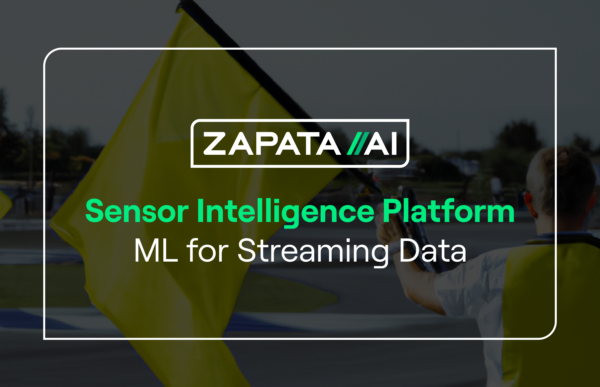Can Quantum Computing Be Part of the Solution to Climate Change?

Can Quantum Computing Be Part of the Solution to Climate Change?

It’s now or never if we want to limit global warming to 1.5C. Without immediate and deep emissions reductions across all sectors, it will be impossible.
Jim Skea, Co-Chair of the IPCC Working Group III
According to the latest report from the Intergovernmental Panel on Climate Change (IPCC), we have until 2025 to reduce our greenhouse gas emissions or face a climate catastrophe. The alarms are ringing, and the message is clear.
At Zapata, we believe that quantum computing can be a part of the solution to put us on a more sustainable course. In this blog post, I will outline my thoughts on what quantum computing researchers and enterprise users can do to make an impact.
This is a personal topic for me. I’ve devoted my career to advancing the field of quantum computing and I’m also committed to doing all I can to address the climate crisis. Outside of my work with Zapata, I contribute to the research group Q4Climate, which brings together quantum and climate researchers to study how to reduce the pace and impact of climate change. You can read our preliminary assessment of how quantum technology can impact the climate crisis here.
As somebody who is involved in applying quantum computing to the climate crisis, I want everybody to be clear-eyed that quantum computing could be one of many parts to the solution. The climate is an extremely complex global system and resolving the crisis will require a combination of public policy, technology, and sociocultural change on a massive scale.
The last thing we want to do is fuel hype that could divert attention from more immediate and impactful measures to address the crisis.
As an Enterprise Quantum software company, we ask, how can enterprises apply quantum computing to reduce their climate impact? This includes leaders looking for new ways to deliver on Corporate Social Responsibility commitments, researchers looking for new ways to create materials, and operations managers looking to reduce waste. Our goal is not to give them an opportunity for greenwashing, but rather to help them be honest in their evaluation of the potential impact and costs of quantum, then help them to take practical action.
With that out of the way, below we share what we believe are some of the most promising quantum computing applications that could help address the climate crisis.
As an Enterprise Quantum software company, we ask, how can enterprises apply quantum computing to reduce their climate impact?
Optimization problems are one of the most quoted near-term applications of quantum computing. They are attractive targets for multiple reasons:
Let’s look at this from the context of climate change. With transportation accounting for 28% of US emissions, supply chain optimization is an intuitive place to start making an impact on sustainability. For perspective, optimizing US trucking routes by just 5% would eliminate roughly 22 million tons of carbon emissions each year, not to mention meaningful savings in fuel costs.
There are other optimization applications that could have an impact as well. Optimizing traffic, for instance by changing the timing of stop lights, the placement of rotaries, or the path of highways, could reduce idle time and related emissions as well. The electrical grid is another good candidate for optimization, as is the placement of solar panels and wind turbines. The design and operation of manufacturing plants and warehouses could also be optimized to reduce energy costs. I could go on — there’s no shortage of examples that could be added to the list.
Our understanding of both the strengths and the limitations of quantum algorithms is accelerating as we partner with more customers to explore use cases and build applications.
Each use case will have its own unique challenges, but in general, there are three main challenges worth addressing in the context of using quantum computing for optimization. Ultimately, overcoming these challenges will be hugely impactful.
The first challenge is that we are in the early years of learning which optimization problems quantum computing will be best suited for. However, our understanding of both the strengths and the limitations of quantum algorithms is accelerating as we partner with more customers to explore use cases and build applications.
In some cases, a classical approach will likely still come out ahead — even several decades from now. For example, for a system that requires real time optimization on the order of milliseconds (e.g. in energy networks), it wouldn’t matter how powerful the quantum algorithm is if the communication overhead is more than that.
That’s one of the reasons why piloting solutions is crucial in quantum computing: it allows us to focus on a specific use-case, use real enterprise-scale data and compute resources, and test the potential of outperforming organizations’ current classical solutions when we take into account all the details.
If you ignore the complexities of applying quantum to sustainability, there’s a good chance your efforts might come across as greenwashing or empty hype.
The second issue is that the best-in-class classical optimization algorithms are already very good. They don’t guarantee the best solution — they are heuristic algorithms — but they can give practical solutions that work well enough for most contexts. Neural networks are another example of an effective computing system without theoretical guarantees: this doesn’t make them less useful. This may be the case with quantum optimization algorithms as well.
Quantum optimization algorithms would likely also be heuristic algorithms in the near term, and in practice, they would be competing against these classical heuristic algorithms. Classical solvers such as Gurobi or CPLEX are the targets quantum methods will need to outperform.
But why compete when you can work together? This is the idea behind Generator-Enhanced Optimization (GEO) — an algorithm we developed at Zapata, which uses a quantum or quantum-inspired generative model to improve on results that have been obtained from a classical optimizer.
We’ve already shown that GEO can improve upon the results of a best-in-class classical optimizer for a financial portfolio optimization problem. We also worked with BMW to show that GEO could boost classical optimizers to produce more optimal solutions for a plant optimization problem.
The third issue is the rebound effect — wherein increasing the efficiency of resource consumption increases the consumption of that resource in the long term. A great example of that is building more highways to reduce congestion. It works in the short term, but in the long term it just worsens the problem. One can imagine scenarios where a quantum-enhanced optimization ends up increasing resource use, for example in the traffic optimization example mentioned earlier.
To be clear, none of this means that quantum computing will not help with solving optimization problems related to climate change. It just won’t be as simple as the “quantum computing will optimize supply chains and reduce emissions” statements that you might have heard in the past. If you ignore the complexities of applying quantum to sustainability, there’s a good chance your efforts might come across as greenwashing or empty hype.
You can read more about optimization, quantum computing and climate change in this paper by Q4Climate I mentioned earlier.
Another area which is often mentioned as an example of how quantum computers could help with the climate crisis is chemistry and materials simulation.
This makes sense intuitively: quantum devices are governed by the rules of quantum mechanics, which also dictate the behavior of molecules. Moreover, we already know which algorithms can achieve exponential speedups over comparable classical chemical simulation methods. Having quantum computers capable of running these algorithms will open up new possibilities which are truly out of reach for classical computers.
Quantum computers could be used to simulate novel electrode materials, electrolyte materials, and other battery components for renewable energy storage.
An example which is often brought up is nitrogen fixation — a process involved in the manufacturing of synthetic nitrogen fertilizer. This process is responsible for 2.4% of annual worldwide CO2 emissions. However, bacteria on the roots of plants fix atmospheric nitrogen in the soil naturally with virtually zero emissions. A key component of this reaction is a molecule called FeMoco.
Quantum computers could simulate the chemical reactions, proteins and enzymes involved in this process. It’s estimated it would take 100 logical qubits to perform the necessary simulation of nitrogenase proteins in cyanobacteria, which could lead to zero-emission fertilizers.
Batteries are another promising application of quantum chemistry. Renewable energy sources like wind and solar are highly dependent on the weather, and thus require efficient batteries to store excess energy for when the energy source is no longer available. More efficient batteries would also extend the range of electric vehicles. Here, quantum computers could be used to simulate novel electrode materials, electrolyte materials, and other battery components for renewable energy storage.
IBM and Daimler are already making progress in this area, using quantum computers to model the dipole moments and ground state energy of molecules that could be used in the next generation of lithium-sulfur batteries.
Similarly, quantum computers could be used to simulate new materials for carbon capture technologies (I’m well aware of the controversies around carbon capture technologies. Still, I believe that if we could really make it work, that would be a huge win.) There are currently no cheap or readily available catalysts for CO2 reduction, preventing wider adoption of carbon capture tech. Quantum simulation could help discover new catalysts that could more cheaply capture carbon at scale, which could then be used to make metals, plastics, and concrete. Recent work by researchers at Quantinuum has made headway in this area, modeling carbon capture materials using today’s quantum devices in conjunction with classical methods.
Again, it all sounds great, so what would be the catch here?
New molecules are just the beginning of an R&D process; they still need to be tested, manufactured, and commercialized.
The first issue is timelines. All the estimations made so far of how big a quantum computer would need to be for these calculations are quite crude and unreliable. In general, resource estimation is a really hard task. At our current stage, it requires a lot of assumptions — some of which may turn out to be wrong as we deepen our understanding of the science and engineering behind quantum computing — hence the unreliability. For FeMoco, the initial estimate was around 100 logical qubits, but further research challenged this. At this stage, we cannot reliably predict what parameters a quantum computer would need to have to solve these problems, how long it would have to run to get the results, or when such a machine will exist.
It should also be noted that the results of quantum simulation are usually not immediately useful in the same way as the solution to an optimization problem. Precise knowledge about the properties of a given molecule is useful, but this is only one piece in a big puzzle. New molecules are just the beginning of an R&D process; they still need to be tested, manufactured, and commercialized.
Combining these two issues with the fact that the timelines for climate issues are quite pressing means that we are in a race to prove quantum computing can make a difference for chemical simulation use cases.
That said, we’re already making progress to shorten the timeline to make quantum simulation a practical reality. One interesting technique we developed at Zapata is Robust Amplitude Estimation (RAE), which reduces the quantum resources required (such as circuit depth) — at the expense of runtime. RAE works well on both near-term devices and fault-tolerant machines. Such methods might help us to get some useful results sooner than the arrival of fully fault-tolerant quantum devices.
Although we’ve made great strides in advancing sustainable uses for quantum computing, we still have work to do.
Quantum computing certainly has promise to address the climate crisis, but — in case I haven’t made myself clear — it won’t be easy. Although we’ve made great strides in advancing sustainable uses for quantum computing, we still have work to do.
Advancing quantum solutions for sustainability will require close collaboration between quantum experts and the domain experts who understand the bottlenecks in molecular discovery and industrial optimization problems. If we combine our knowledge, we can better determine where the lowest-hanging fruit will be and predict what impact we can pursue together.
At Zapata, we’re always looking for industry partners to collaborate with in building a more sustainable future. If you’re interested in doing the hard work with us, we want to do the hard work with you. In my next blog post, I’ll lay out a practical course of action for the work that needs to be done to make quantum sustainability a reality. Read Part 2 here.
Michał Stęchły, Quantum Software Engineer


